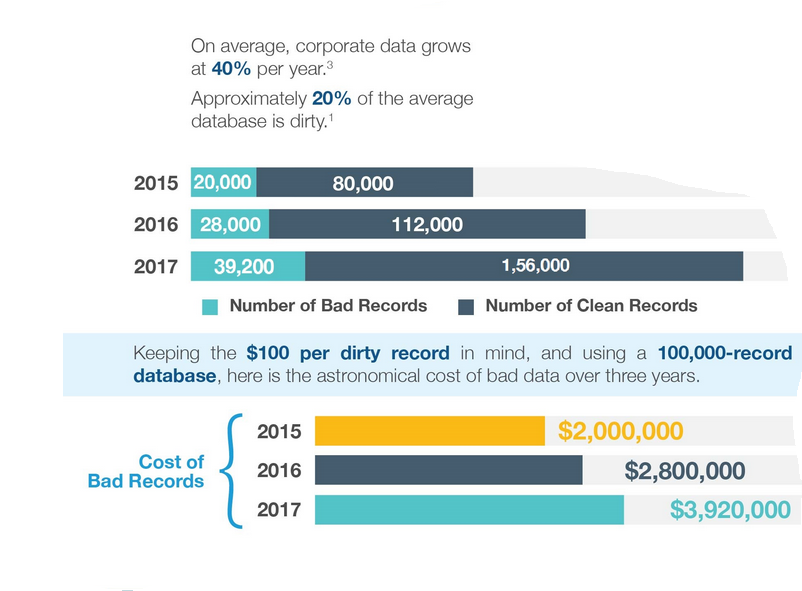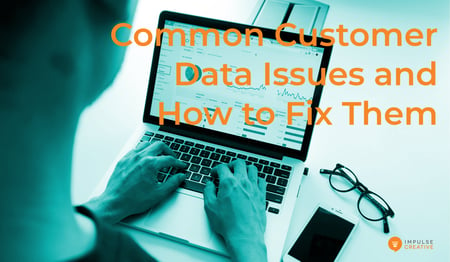Customer data is the lifeblood of your business. It enables you to effectively personalize and tailor your marketing messaging, provide your sales reps with context as they engage with prospects, and help your support and success teams to better serve your customers.
Most companies know this. However, bad data still costs your average company more than $3 million per year.

Source: Neil Patel
According to a webinar from DiscoverOrg CEO Henry Schuck, sales departments lose approximately 550 hours and $32,000 per sales rep from using bad prospect data. An Experian study found that 69% of companies across all industries state that data quality issues undermine their customer experience efforts.
Too few companies place enough focus on data quality to launch internal data quality initiatives and invest in tools that can help them to improve. Too much attention is paid to collecting more data, as opposed to making the most of the data that they have already collected.
In this article, we’ll cover some of the most common customer data issues found in CRMs across industries. Then we’ll provide some simple tips for mitigating those issues moving forward.
Data Issue #1: Duplicate Contacts
 Duplicate contacts are the most visible of all data issues because they cause easily identifiable problems throughout the customer journey. Contacts may receive multiple emails or mixed marketing messages. Sales teams will find that they lack important context in sales conversations and negotiations.
Duplicate contacts are the most visible of all data issues because they cause easily identifiable problems throughout the customer journey. Contacts may receive multiple emails or mixed marketing messages. Sales teams will find that they lack important context in sales conversations and negotiations.
Duplicate sheep? Okay. Duplicate contacts? Not okay.
They have a real financial impact on every organization. Recent studies have shown that 15% of leads contain duplicate data.
In the data management industry, there is the commonly cited “1-10-100” rule. This rule states that it costs $1 to verify records and prevent data errors, $10 to cleanse and deduplicate records, and $100 if nothing is done about the bad data.
How to Fix Duplicate Contacts
Fixing and preventing duplicate contacts can be tricky, especially when you have multiple touchpoints where customer input data is added to your CRM.
Fixing a duplicate contacts problem starts with prevention. Being able to identify the duplicate records before (or as soon as) they hit your CRM is critical for preventing them moving forward. When duplicate records hit your database, there is a good chance that only one of the records will be updated moving forward. That means that your data for that customer will be split between two different records, shattering your single customer view.
Many CRMs offer some features that can help you to identify duplicate customer records and merge them. HubSpot, for instance, allows you to identify duplicate contacts by usertoken, name, email, or company domain. That sounds great, but often this is not enough. Many duplicate customer records or only partial matches that must be matched using different fields like phone numbers and addresses.
While you can use complicated Excel VLOOKUP formulas to identify duplicates, you’re still likely to miss some as there are many variables. You’ll likely need the help of a tool to have confidence that you have caught nearly all of the duplicate data in your CRM.
Tools like Insycle allow you to identify duplicates using any field in your customer database and merge them in-bulk. Insycle not only allows you to find exact-match duplicates, but partial match duplicates as well. This ensures that you catch more duplicates. Insycle also allows you to set up automated deduplication processes on an hourly, daily, weekly, or monthly basis to keep your CRM duplicate-free.
Data Issue #2: Inconsistent Formatting & Case
Inconsistent formatting and case issues are extremely common in every customer database. They can be a big problem. Inconsistent formatting could throw a wrench in your marketing or sales automation systems.
Phone numbers serve as an excellent example of a customer data field that often sees inconsistent formatting.
Phone Number Formatting
- 123-456-7890
- 1234567890
- (123)-456-7890
- 1-123-456-7890
- 1-(123)-456-7890
- +1 123 456 7890
- 123.456.7890

You might use an auto-dialer software for your sales team that requires specific formatting. Or maybe you just want your data to be easy to read.
Other fields, like addresses, city (NY vs. New York), State, and zip code among others, have their own formatting concerns as well.
Case issues like names being improperly capitalized can lead to embarrassing marketing automation mistakes that lift the veil on the conversational tone of your messaging. This applies to any field that requires specific capitalization practices.
How to Fix Inconsistent Formatting
Fixing inconsistent formatting begins with prevention. Adding appropriate restrictions to customer (and internal) input forms is a good place to start.
For instance, you’ll probably never want to allow a customer to input a “First Name” that isn’t capitalized. On all customer-facing forms, you can include form validation that requires proper case or automatically fixes common case issues before the data hits your CRM. Once the data is already in your CRM, you can use Excel to change the case of records in those fields, or invest in data cleansing software.
Data Issue #3: Inaccurate Customer Data
Data quality issues don’t just come in the form of errors. Inaccurate customer data is also a huge concern.
According to a study from Integrate, 40% of leads contain inaccurate data. Companies believe, on average, that up to 33% of their customer data is inaccurate in some way. That inaccurate data may include intentionally misleading information from customer inputs and outdated information. 30% of people change jobs annually. This means that data in your B2B customer database can become inaccurate quickly.
How to Fix Inaccurate Data
Fixing inaccurate data can be difficult. Data can be inaccurate, but appear to be error-free when inspected. To combat this, companies should invest in data enrichment initiatives. Not only will this help companies to collect more data about their prospects, but it will help them identify outdated and inaccurate data that they currently house in their CRM.
Data Issue #4: Missing Customer Data
If you take a look in your CRM database right now, you’ll likely find many records that contain missing data. Maybe you don’t have a phone number for one prospect or an address for another. Of course, if you go to use that blank data field in your marketing automation, your messaging may suffer.

How to Fix Missing Data
Like inaccurate data, fixing missing data requires an investment in data enrichment. Investigating missing data and filling in those fields by hand is unrealistic and time-consuming. However, enriching your records with data from a high-quality data source can help you to fill in the missing pieces and enjoy a more complete picture of each prospect and customer.
On customer input forms, you can also reduce missing data by increasing the number of required fields. Of course, there is a trade-off. If you require your prospects and customers to fill in every field on a form, you’re likely to enjoy a lower conversion rate with higher quality data.
Your Data Quality Solution
Insycle is a customer data management tool that can help you to remedy the most common data issues in your CRM. Insycle connects directly to popular CRM platforms like HubSpot, Salesforce, and Intercom and gives you a complete birds-eye-view of your data while helping you to identify and remedy common data issues.
Using Insycle, you can:
- Identify and bulk merge duplicate contacts using any field in your database
- Fix inconsistent formatting and case issues across your CRM
- Find and update missing and inaccurate customer fields
- Identify and remove redundant data
Poor quality customer data is rampant in most CRMs and harms your marketing, sales, and support initiatives. However, with some practical preventative measures and an investment in data cleansing and enrichment software, you can drastically reduce low-quality data in your CRM.
Data photo by Campaign Creators on Unsplash
Sheep photo by Jørgen Håland on Unsplash





